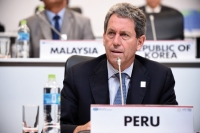Peru: Peru should address this industry with a comprehensive reform, the country’s energy policy
2015/09/28

Beatriz Merino, President of Sociedad Peruana de Hidrocarburos (SPH) sits down with United World to discuss the current situation of the country’s energy mix and the role of both public and private sector in the country’s Energy industry increase.
Peru has led the region in the recent years with an average 6% increase rate. We would like you to comment on the contribution of the energy sector to the dynamic of Peru’s economic increase during the last decade.
The contribution of the hydrocarbon industry to Peru’s GDP was developed in one of the reports based on official data that we presented, which states that between 2007 and 2013 the contribution to this increase was of an order of 10%, that is, a total accumulation of 70.000 million Soles to the country’s economy.
Between 2004 and 2013, 89 exploratory wells have been drilled, about nine per year, which is still a low number in international competitiveness terms.
The hydrocarbons industry contributes nearly 9% of the tax revenue from commercial activities, and in general terms, from 100 new soles that the tax government collects, six come from this activity.
On average, between 2003 and 2013, it has contributed with 6% of the total country’s collection and in these terms it has grown 25%. This increase is as well represented in the royalties, which are 10 times higher than the ones coming from the mining sector as rates are higher in our sector.
On the other hand, it is significant to remark that, through the system of fees and duties, the hydrocarbon industry is the biggest contributor to regional tax collection. In regions such as Cuzco, Loreto or Huanaco, part others, we would be talking of 85% of the budget for current expenditures.
This means that the downturn of the sector is going to have a strong impact at a local level.
Aiming at achieving energy security for the country, how does Peru exploit all potential of the sub-Andean region?
I think that Peru should address this industry with a comprehensive reform, starting by giving the national public policy of hydrocarbons the necessary priority inside the country’s energy policy.
It is currently mixed part other priorities and that is one of the reasons why we have seen the fall of its presence in the public and in the media schedule, both at local and international level.
Therefore, considering that the current government is finalizing its mandate, it is very significant to declare which is the schedule for hydrocarbon for the next five years in Peru.
As I have mentioned, in the initial place the necessary priority should be given inside the whole energy policy. In a second stage, I think we need to redesign the National’s institutional framework to transaction with this field.
The importance of the contribution of this industry to the national economy should be reflected in the government institutions. Currently, the hydrocarbons sector is represented by a National Direction, which is at the same time inside a Vice ministry inside the Ministry of Energy and Mines, which in my opinion is a flaw that the Peruvian government needs to fix.
It would be convenient if this government, before it finishes its term, left as a legacy at least the creation of a Vice ministry of Hydrocarbons, providing the sector with a stature in line with its contribution to the national economy.
Thirdly, we still have the setback of the regulatory framework.
Peru has succeeded in attracting oil and gas companies and top-rated international projects, but still 65% of the hydrocarbon basin remains unexplored, not even getting to produce 60.000 barrels per day while neighboring nations, such as Ecuador, reach around a million barrels per day.
I think we have fallen into the trap of endless and inexhaustible red tape and we have lost the opportunity of oil being above US$ 100. While oil was reaching or even exceeding that price, the oil companies in Peru were in the bureaucrats’ offices trying to have their permits approved.
While in neighboring nations with new findings of oil fields extracting oil would have taken around 4 years, in our country that could easily take 17. That is why today, as oil is around US$ 60, Peru has the opportunity to redesign its whole system of procedures and permissions to make it intelligent, just, flexible, executable and highly competitive at the international level, while as well taking into account the protection of the environment and indigenous peoples.
Naturally, these actions must be complemented with the advance of credits to infrastructure. The Southern Gas Pipeline is by presently being developed and its increase potential will be very significant; an extra project to build a gas pipeline in the northern region is as well being debated.
The lesson is that we should take chance of this crisis to redesign Peru towards energy autonomy and security for the next five years.
What is the responsibility that lies on the private sector in these aspects that you are pointing out? Should the private sector promote these policies and negotiate with the public sector? As the private sector goes beyond the government mandates, in which way does Sociedad Peruana de Hidrocarburos manage these synergies with the government?
We are a union that was created only two years ago. Out initial task was to produce a white book of hydrocarbons, currently available on our website, with the aim of laying out an schedule to the government.
We actively participate in the Energy Commission of the Parliament to express what the sector’s needs are, and finally some months ago we produced the initial statement on the economic impact of the hydrocarbon activity on Peru, which as well available on our webpage.
This statement became relevant as it was the initial time that it was made public how significant this industry is and I think that is the contribution from the private sector, to make proposals.
I understand that Peru is a country with a large mining component; nonetheless, that should not work as an excuse to relegate an industry of our size.
That would be, in my opinion, what would contribute to rapidly promote the country’s increase, because at the same time as the price of oil from presently on recovers, we should be ready to provide all the exploration advantages to the industry.
That is why this crisis stage is the best moment for government actions. We are conversing with a conscious and open National, but the circumstances of having a Government that is about to leave without a certainty of who is going to succeed it postpones decisions on certain policies.
How can you reconcile respecting the environment with the interests of the indigenous communities and continue attracting investment ?
The initial thing we need to recognize in this debate is that, in almost 200 years as a Republic, the Peruvian National has given its back to the needs and constitutional rights of the indigenous peoples.
This means that they are the majority neglected by the government in education, health, security and fundamental human rights. Secondly, there is an asymmetry between large companies and these abandoned communities.
That is why during my mandate as Public Advocate I fought for the creation of the Ministry of Environment, because my perspective – shared by all the companies participating in the Society – is that the government has to be an arbitrator in matters of the extractive industry, protecting the majority vulnerable, who are the indigenous peoples in this case.
The third issue to transaction with is that in these conditions of isolation, as it is the case of the Amazon, at the same time as the oil company shows up and starts approaching communities through its social responsibility projects, the initial things they ask for is precisely health, education, nutrition, electricity and basic rights, all of which should be obligations from the government and not the private sector.
However, from the observation of the social responsibility actions carried by the member companies of this society, you notice that in these issues they collaborate with the communities.
That is why social conflicts are not in the initial line of problems of oil companies, as its relation - in general terms – with the communities is not bad. Besides, in order to be listed on the different stock exchanges, these companies are subjected to audits that include topics such as human rights and the environment, forming a virtuous circle. If we add to all this the fact that these communities know that the canon these companies pay makes up a large part of local governments budgets, the virtuous circle is always reinforced.
In the case of the environment, it is the same. Something that I quickly learnt in this industry is that environmental degradation is a human disgrace and that the protection that we owe to the planet is a moral mandate.
All of us have the obligation to take care of our home, to defend it and keep it well for the ones that will come next us. Furthermore, an oil accident is an economic catastrophe: that was the case of British Petroleum, as stocks plummeted and a third of the personnel was laid off.
No industry is immune to accidents, but the commitment is there. I oppose the positions that hold that the industry should be kept away from this country, as those benefits remain out of our system and do not reach the majority vulnerable, making their isolation and poverty a permanent thing.
What are the relations of the sector with American companies? What is the potential for development and promotion of these investments, not only in terms of capital but as well regarding the brands, as the large names of this industry are American?
There have been initial-class American companies that have been here and presently, due to the fall in oil prices, there are American hedge funds that are investing in these oil companies.
We are at a time of opportunities: whoever wants to invest in the hydrocarbons industry must look at Peru with interest; it is a modern country that grows and has a stable democracy with very solid institutions in economic matters, a sound banking system and a stock exchange that is integrating into the Latin-American Integrated Market (MILA).
All of this is positive and competitive internationally.
I think that we possess the values that a North American investor looks for: stability, clear and transparent rules of the game and protection of his investment .
On its part, Peru has a free trade agreement currently in force with the United States, it is part of the four additional solid economies of Latin America, it is interested in joining the OECD and it has developed a private arbitrage system, meaning that it provides the conditions that are compatible with what the American investor demands.
Furthermore, we should not forget that the relation between the United States and Peru is optimal and respectful, with a good reciprocity and integration at the time of receiving immigrants in each country and with a lot to learn from the pending agendas that mutually reinforce each other, such as those of inclusion, cultural diversity and racial discrimination.
I hold a large admiration for the North American society, its values and above all the leadership that their corporate leaders practice and the way they see themselves as responsible of the increase of their country.
The way in which they conceive that the responsibility for the happiness of the society corresponds to the private sector and not the national officers is still a pending issue in Peru, whose leaders should learn how to look at themselves that way.
- Related Articles

Climate change laws around the world
2017/05/14 There has been a 20-fold increase in the number of global climate change laws since 1997, according to the most comprehensive database of relevant policy and legislation. The database, produced by the Grantham Research Institute on Climate Change and the Environment and the Sabin Center on Climate Change Law, includes more than 1,200 relevant policies across 164 countries, which account for 95% of global greenhouse gas emissions.Peru’s new president, Pedro Pablo Kuczynski, pledged to lift GDP growth to 5% by 2018.
2017/04/18 The year 2016 brought both political and economic changes in Peru, with a new government moving quickly to roll out strategic measures aimed at tackling long-standing problems and returning the country to higher levels of increase. Following his election in June, Peru’s new president, Pedro Pablo Kuczynski, pledged to lift GDP increase to 5% by 2018. Bridging infrastructure gaps and addressing the perennial problem of the informal economy were high on the schedule, with a series of 112 measures announced to steer the government’s policy schedule forward.
Presidencia Perú
2017/03/04 The PPK cabinet has been working diligently to modernize the country and replace business confidence, while unlocking investments and infrastructure megaprojects in a bid to boost the country’s economy

FuXion Biotech: Ancient Andean and Amazonian heritage combined with the latest scientific advances in cell biology and human nutrition
2016/03/01 In 2006, next having worked for additional than 15 years in the food processing and manufacturing industry, Álvaro Zúñiga Benavides founded FuXion, a incomparable venture specialized in high-quality food and food supplements.
- Peru News
-
- ISRAEL: Netanyahu’s Historic Latin American Tour to Highlight Israeli Tech Sector
- ISRAEL: PM Netanyahu leaves on historic visit to Latin America
- AFGHANISTAN: UNWTO: International tourism – strongest half-year results since 2010
- PERU: Peru’s Protected Area System: A Key Component Of Ecotourism
- PERU: Peru pursues tourism revenue growth both at home and abroad
- BRUNEI : The next chapter for the Trans-Pacific Partnership
- Trending Articles
-
- CAMEROON: Cameroon: Giving Priority to Education
- CAMEROON: Cameroon: English-speaking Students Do Not Return to School
- RWANDA: Rwanda: RDB's Good Problem - More Gorillas, Less Habitat
- ANGOLA: Angola's Elections Trigger a Crisis of Legitimacy
- BURUNDI: Burundi: Govt Rejects UN Accusations of Crimes Against Humanity
- SOUTH AFRICA: Zimbabwe Election Commission keen to avoid Kenyan situation












